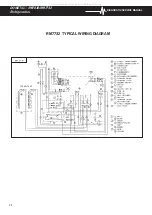
9
DIAGNOSTIC SERVICE MANUAL
DOMETIC® RM7030/RM7732
Refrigerators
SECTION 2
AC VOLTAGE REQUIREMENTS
The refrigerator is a 120 volt AC, 60 Hz appliance. The
proper operating range is
100 to 132 volts
. Check the
AC volts at the receptacle where the refrigerator is
attached. If voltage is outside of the proper operating
range, correct the power source problem.
On RM7030 (Product No. 921890401) and RM7732
, if
voltage drops below 100 volts, cooling efficiency will
decrease with voltage decrease. The refrigerator will not
switch to another mode of operation until all
AC power
is lost
.
SECTION 3
AC COMPONENTS
HEATING ELEMENT
The heating element is designed to deliver a predeter-
mined amount of heat to the cooling unit. To check a
heating element, remove the heater leads from the
printed circuit board and measure for proper resistance
across the two leads with a properly calibrated ohm
meter. This check is to be done with the heating ele-
ment at room temperature. The proper ohms for each of
the two RM7030 and RM7732 heating elements is 69,
with a tolerance of ten percent. If the resistance is
outside the tolerance range, replace the heating ele-
ment.
SECTION 4
DC VOLTAGE REQUIREMENTS
A. RM7030 (Product No. 921890201 &
921890301)
For the refrigerator to operate on any mode, DC voltage
must be supplied to the terminals at the rear of the
refrigerator and must be connected directly to the
battery of the RV. The operational range is 10.5 to 15
volts DC. Connecting the refrigerator to an unregulated
converter can result in improper operation of the refrig-
erator. Do not use the body or chassis of the RV as a
substitute for either of the two conductors. Proper
polarity is crucial for the operation of the refrigerator.
Check for proper voltage at the positive and negative
terminals at the back of the refrigerator. If power is
outside the operational range, correct the power supply
problem. The power supply to the refrigerator must be
fused. Maximum fuse size: 5 amps.
With the refrigerator operating on AC or gas mode, if
voltage to the refrigerator slowly drops to or below 9.5
volts DC, the gas flame will come on and will not be
thermostatically controlled. Low DC volts (below 9.5)
could cause over-cooling.
B. RM7030 (Prod. No. 921890401) & RM7732
For the refrigerator to operate on any mode, DC voltage
must be supplied to the terminals at the rear of the
refrigerator.
The operational range of the unit is a minimum of 9.6V
DC to a maximum of 22V DC. The unit will automatically
shut down until voltage has decreased to 18V DC. The
refrigerator requires at least 9.6V DC for proper opera-
tion; however, the panel lights will continue to illuminate
until voltage has dropped to 4V DC or below.
Connecting the refrigerator to an unregulated converter
can result in improper operation of the refrigerator. Do
not use the body or chassis of the RV as a substitute for
either of the two conductors. Proper polarity is crucial
for refrigerator operation. Check for proper DC voltage
at the positive and negative terminals at the back of the
unit. If the voltage is outside the operational range,
correct the power supply problem.
SECTION 5
DC COMPONENTS
5.1
THERMOSTAT
RM7030 (Product No. 921890201 & 921890301)
The thermostat operates on DC volts and regulates the
inside refrigerator temperature on all modes, by making
and breaking the circuit to the printed circuit board. The
internal mechanism breaks contact (continuity) when
adequate cabinet temperature has been reached.
Check the thermostat for continuity. This check should
be made at room temperature with the thermostat
turned all the way to MAX. Another check would be to
use a jumper wire with insulated clips and bypass the
thermostat.
NOTE: Use care when doing this test. Do not short to
thermostat casing. Also remove jumper after testing is
completed.
If the above test allows the refrigerator to operate and/
or the continuity test proves the thermostat to be
defective, replace the thermostat. A defective thermo-
stat would cause insufficient cooling, no cooling or
freezing on all modes.
All manuals and user guides at all-guides.com













































